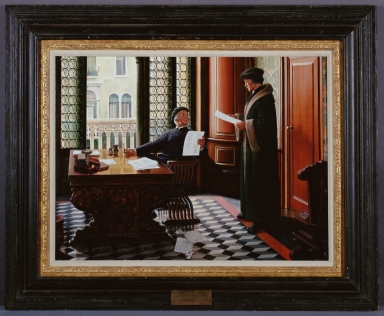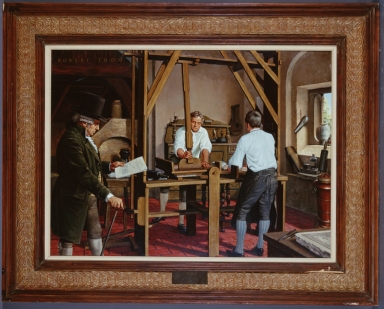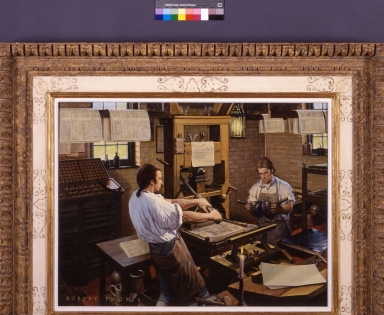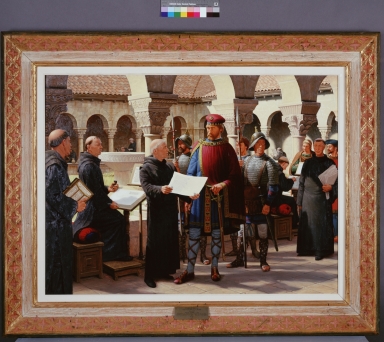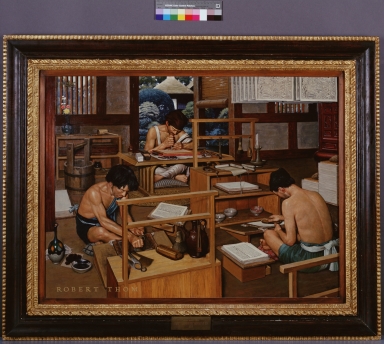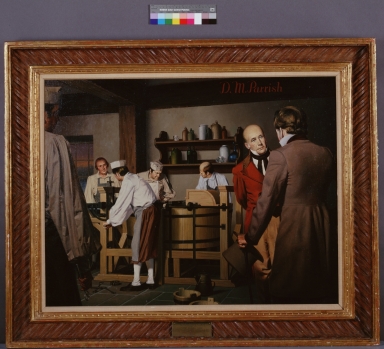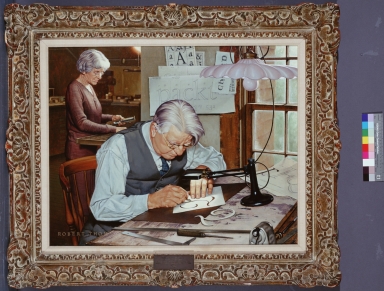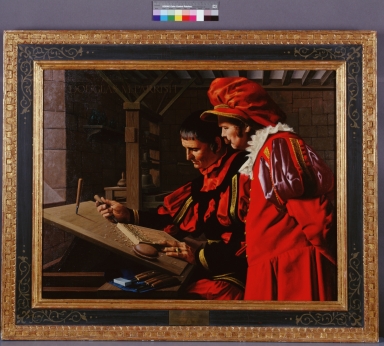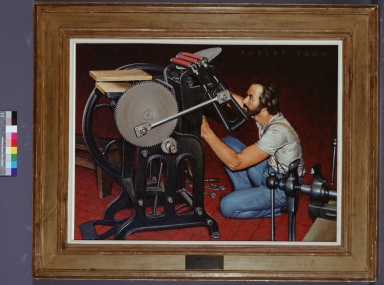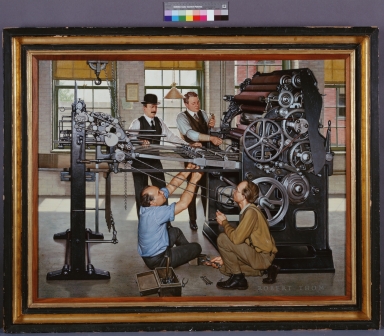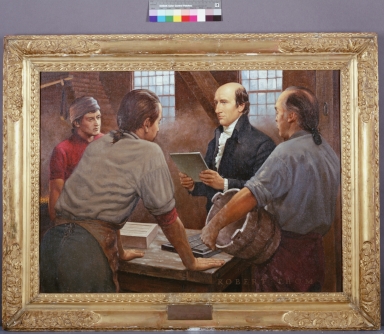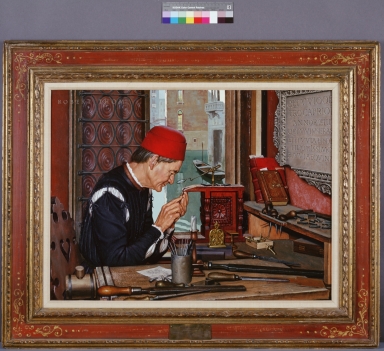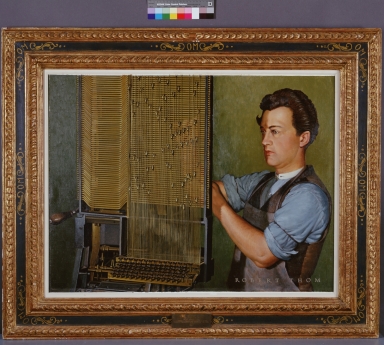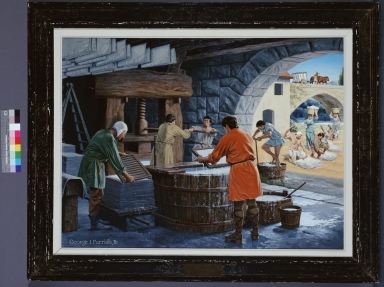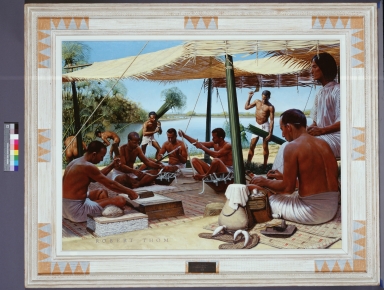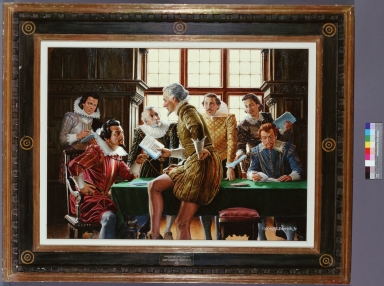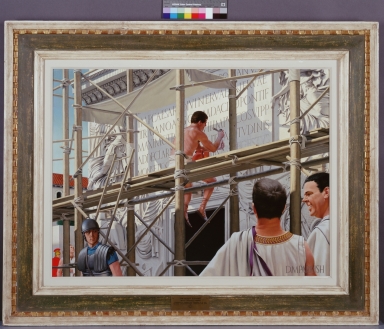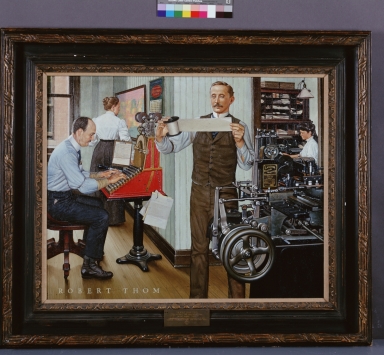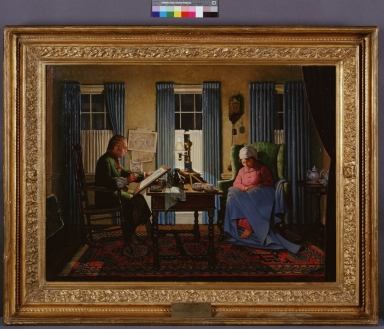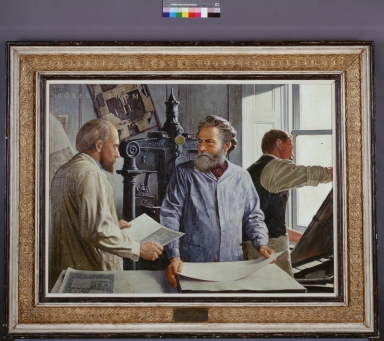|
REFINE
Search Results: All Fields similar to 'Kimberly and Clark'
1-29 of 29
Title
Aldus Manutius
Creator
Thom, Robert A., 1915-1979
Summary
Perhaps the greatest figure in book publishing history, Aldus Manutius established a printing firm in Venice during the Fifteenth Century which published "pocket-sized" editions of Greek and Latin classics at low cost. His Aldine Press made it possible for commoners to read Aristotle, Euripides, Plato and Plutarch. The works were distinguished by typographical beauty and accuracy of scholarship. He was the first printer to use small capitals and italics; he authored one of the first Greek-Latin dictionaries, and founded an academy of famous Greek scholars.
Title
Alois Senefelder and Lithography
Creator
Thom, Robert A., 1915-1979
Summary
Near the close of the century, a young Bavarian playwright named Alois Senefelder sought a method of printing his own plays. His first efforts were engraved and etched on copper and printed on a makeshift intaglio press. The high cost of copper led Senefelder to experimentation with limestone slate. In 1796, a happy accident occurred. Having no paper immediately at hand, Senefelder wrote out an urgently needed laundry list on a polished piece of stone with a greasy ink mixture. Curiosity led him to the discovery that it was not necessary for the printing surface to be raised in the usual manner. The greasy image surrounded by the water-attracting stone surface accepted ink, while the dampened part of the stone rejected it. Printing from a plane or level surface, of lithography as we know it was born. Pursuing his discovery, Senefelder succeeded in adapting his process to metal plates by 1803.
Title
Alois Senefelder and Lithography
Creator
Thom, Robert A., 1915-1979
Summary
Near the close of the century, a young Bavarian playwright named Alois Senefelder sought a method of printing his own plays. His first efforts were engraved and etched on copper and printed on a makeshift intaglio press. The high cost of copper led Senefelder to experimentation with limestone slate. In 1796, a happy accident occurred. Having no paper immediately at hand, Senefelder wrote out an urgently needed laundry list on a polished piece of stone with a greasy ink mixture. Curiosity led him to the discovery that it was not necessary for the printing surface to be raised in the usual manner. The greasy image surrounded by the water-attracting stone surface accepted ink, while the dampened part of the stone rejected it. Printing from a plane or level surface, of lithography as we know it was born. Pursuing his discovery, Senefelder succeeded in adapting his process to metal plates by 1803.
Title
Benjamin Franklin
Creator
Thom, Robert A., 1915-1979
Summary
One of America's greatest patriots, a framer of the Declaration of Independence, a statesman whose charm and tact played a tremendous role in securing for the Colonists the aid of France during the Revolutionary War, Benjamin Franklin was also a skilled scientist, author, editor, publisher and printer. Beloved among his many writings was the series of Poor Richard's Almanacs, published annually between 1732 and 1758 in issues as large as 10,000 on a hand press. The volumes quickly gained a wide and appreciative audience, and their homespun, practical wisdom exerted a pervasive influence upon the American character.
Title
Charlemagne and the Monastic Scribes
Creator
Thom, Robert A., 1915-1979
Summary
One of the earliest monarchs to bring unity from the chaos which followed the destruction of Rome was Charlemagne, King of the Franks. With his trusted advisor and chief aide, Alcuin, a Benedictine Monk, Charlemagne established schools to educate monastic scribes in copying ancient manuscripts during the eighth and ninth Centuries. Through the painstaking handwriting of his scribes on parchment, the reign of Charlemagne is credited with preserving for posterity the knowledge and culture of the great civilizations of Greece and Rome.
Title
Chinese Block Printing
Creator
Thom, Robert A., 1915-1979
Summary
The world’s oldest book, the Diamond Sutra, was printed from wood blocks by the Chinese in 868 A.D. It wasn’t until 1293, however, that paper made from linen and cotton pulp supplanted the tree bark used by the Chinese for paper.
Title
Fourdrinier and the Papermaking Machine
Creator
Parrish, Douglas M., 1922-2001
Summary
At the turn of the 19th century Louis Robert, a French paper mill clerk, invented a paper manufacturing machine to replace hand labor. Prevented from developing it because of political troubles in his homeland, he sold the idea to Henry and Sealy Fourdrinier, prominent paper manufacturers. The Fourdriniers continued experimenting and in 1803, designed a machine which could produce a sheet of paper.
Title
Frederic E. Ives and the Half-Tone Process
Creator
Thom, Robert A., 1915-1979
Summary
The method by which most pictures are processed for letterpress printing is called photoengraving. The procedure was developed in 1878 by Frederic E. Ives, an American technician and inventor from Philadelphia. Ives' method consists of breaking down photos or drawings into tiny dots of varying sizes. The image to be reproduced is photographed through a ruled glass screen which breaks up the different tones into dots, the number of which is determined by the fineness of the ruled lines on the screen. It is then etched into relief on a copper plate for letterpress printing.
Title
Frederic W. Goudy
Creator
Thom, Robert A., 1915-1979
Summary
The most prolific as well as the most articulate of American type designers, Frederic W. Goudy, was also beginning a notable career at the turn of the century. In 1903, Goudy and his wife Bertha established the Village Press at Park Ridge, Illinois, later transferring their operations to New York. During his lifetime he designed more than 100 new type faces, among them Kennerley, considered by some experts the most beautiful since the works of the 18th Century master, William Caslon. He wrote "The Alphabet," "Elements of Lettering," "Typologia," and "A Half Century of Type Design," receiving many academic and graphic arts honors including the gold medals of the American Institute of Graphic Arts and the American Institute of Architects before his death in 1947.
Title
Friederich Koenig and the Cylindrical Press
Creator
Parrish, Douglas M., 1922-2001
Summary
After centuries of use, history's oldest printing machine, the hand press, was finally superseded when Frederich Koeing sold his first power-driven press to The London Times in 1814. Koeing's invention instantly lowered printing and composing costs by 25 per cent and made possible the production of cheaper and larger publications of every kind. His contributions to the graphic arts were presses with increased multiplying capacities which soon replaced manpower with machine power. From his inventions came today's entire line of modern, high speed printing machines.
Title
Geoffroy Tory and Simon de Colines
Creator
Parrish, Douglas M., 1922-2001
Summary
One of the most versatile men in the history of printing, Geoffroy Tory was a sixteenth century French engraver, publisher, author, orthographer, scholar, type designer, and printer. Unfortunately, he is known in most circles only for a series of magnificently ornate border engravings he designed for the "Book of Hours," a religious work printed by Simone de Colines in 1525. He is also somewhat known for writing the revolutionary book, "Champfleury," which discouraged French authors from using Greek and Latin in their works instead of French.
Title
George P. Gordon and the Platen Press
Creator
Thom, Robert A., 1915-1979
Summary
The first of an illustrious line of Gordon job presses, standard equipment for commercial printing for years, was invented and put on the American market by George Phineas Gordon in 1851. The press was a small jobber operated by a treadle, and it had no throw-off. Gordon presses have appeared in various forms since the inventor's early model and are still operating and turning out job printing as efficiently as they did in the 19th century.
Title
Ira Rubel and the Offset Press
Creator
Thom, Robert A., 1915-1979
Summary
A milestone in graphic arts history occurred in the early 1900s when a New Jersey printer named Ira Rubel accidentally used a rubber cloth as a cylinder on a lithographic press. Due to Rubel’s negligence in feeding paper, an impression was made on the cloth. When the next sheet went through the press, an extremely vivid impression was obtained on its reverse side. On the basis of this principle, Rubel invented his offset press in 1905.
Title
Johann Gutenberg and Movable Type
Creator
Thom, Robert A., 1915-1979
Summary
Johann Gutenberg is popularly miscredited with inventing movable type in the 1450s. (This was invented in 1040 A.D. by Bi Sheng in Asia). His real contribution to the history of communications, however, was that he was the first man to successfully combine all the necessary printing components: type casting, ink manufacture, punch cutting, composing, a press and paper, into a single workable system and reach a point of technical efficiency which was not surpassed until the nineteenth century. Although another printer finished publishing his magnificent "42-Line Bible," poetic justice for his significant contributions led historians to attribute the entire accomplishment to Gutenberg.
Title
John Peter Zenger
Creator
Parrish, George I., 1930-1992
Summary
An American colonial printer and publisher, John Peter Zenger, was the defendant and focal point in a famous trial which established the first significant victory for freedom of the press in America. As publisher of the New York Weekly Journal, he was accused of printing libelous statements about the colonial government. His attorney, Andrew Hamilton, argued that Zenger's allegations were true and therefore not libelous. The jury accepted Hamilton's thesis and freed Zenger. This momentous verdict established truth as the criterion in all future American libel suits.
Title
Lord Stanhope and Stereotyping
Creator
Thom, Robert A., 1915-1979
Summary
Shortly after the turn of the 19th century, Charles Mahon, Third Earl of Stanhope, became interested in reestablishing stereotype printing in England. Although stereotyping had twice been introduced in his country, it had fallen into disuse for many years. Stanhope, a political radical who ultimately seceded from the House of Lords, perfected stereotyping from plaster molds in 1804. His process offered many obvious advantages wherever books - such as bibles, prayer books and school books - were being constantly reprinted. It substantially reduced the wear of type and the expense of keeping it standing for future use.
Title
Lord Stanhope and Stereotyping
Creator
Thom, Robert A., 1915-1979
Summary
Shortly after the turn of the 19th century, Charles Mahon, Third Earl of Stanhope, became interested in reestablishing stereotype printing in England. Although stereotyping had twice been introduced in his country, it had fallen into disuse for many years. Stanhope, a political radical who ultimately seceded from the House of Lords, perfected stereotyping from plaster molds in 1804. His process offered many obvious advantages wherever books - such as bibles, prayer books and school books - were being constantly reprinted. It substantially reduced the wear of type and the expense of keeping it standing for future use.
Title
Nicolas Jenson
Creator
Thom, Robert A., 1915-1979
Summary
The life of Nicholas Jenson, famed printer and renowned typographer, is the fascinating story of a Frenchman whose destiny was to bring everlasting glory to Italy. Commissioned by King Charles VII to master the secrets of printing for France, Jenson took his knowledge instead to Venice after learning of his beloved monarch's death. There he perfected the clarity, beauty and utility of his superb new Roman type face, a monumental contribution to the graphic arts.
Title
Ottmar Mergenthaler and the Linotype
Creator
Thom, Robert A., 1915-1979
Summary
On July 3, 1886 Ottmar Mergenthaler, an immigrant watchmaker from Wurttemberg, Germany demonstrated to the New York Tribune a machine which was regarded as one of the 10 greatest inventions of all time: the Linotype. Type for nearly every newspaper in the world and most books in the United States was composed by Mergenthaler's machine. His basic innovation was that of circulating matrices, pieces of brass punched with letters, figures and punctuation marks. When an operator tapped the Linotype's keys, the pieces were brought together into a line, automatically spaced, for faces which made a cast impression in type. The matrices were then automatically returned to the machine for future use.
Title
Papermaking at Fabriano
Creator
Parrish, George I., 1930-1992
Summary
Europe's earliest Christian paper mill was established at Fabriano, Italy in 1293. In the manufacturing process, pulp was made from partially decomposed linen or cotton. This cloth was washed, pounded with massive stones or iron pestles and placed into tubs of water. The pulp was then transported to a platter-like sieve through which the water was drained but the pulp held eve. The sieve's frame was removed and the pulp was shaken evenly, integrating the fibers. Finally, the wet pulp was dried by the sun into paper.
Title
Papyrus and Pictography
Creator
Thom, Robert A., 1915-1979
Summary
Although papyrus was used by the ancient Egyptians for sandals, boats, mats and ropes, its real importance was the manufacture of "paper." As the only method of conveying pictographs and written words for centuries, its existence was most significant in the history of communications. The fibrous cores of papyrus stems were first cut into strips. The strips were then pounded together into a single sheet and dried. After the sheet was burnished, a reed pen was used to write on its surface.
Title
Shakespeare's First Folio
Creator
Parrish, George I., 1930-1992
Summary
The first collected edition of the immortal William Shakespeare's plays, known today as the First Folio, was printed by William Jaggard and his son Isaac in 1623. It was issued by a group of booksellers assembled solely for the purpose of publishing the Bard's famous works. The First Folio contains dedications to the Earls of Pembroke and Montgomery; to "the great Variety of Readers," and commendatory verses by Ben Jonson, Hugh Holland, Leonard Digges and an unidentified "I.M."
Title
Shakespeare's First Folio
Creator
Parrish, George I., 1930-1992
Summary
The first collected edition of the immortal William Shakespeare's plays, known today as the First Folio, was printed by William Jaggard and his son Isaac in 1623. It was issued by a group of booksellers assembled solely for the purpose of publishing the Bard's famous works. The First Folio contains dedications to the Earls of Pembroke and Montgomery; to "the great Variety of Readers," and commendatory verses by Ben Jonson, Hugh Holland, Leonard Digges and an unidentified "I.M."
Title
The Roman Alphabet
Creator
Parrish, Douglas M., 1922-2001
Summary
The Romans, beginning their mighty ascent to power, expelled the Etruscans from Rome in 509 B.C., but not before they acquired from them a combination of the Semitic-Greek-Etruscan alphabet. This was then modified and perfected into an alphabet of their own, an alphabet which is the basis of our present day language. Originally, the Roman alphabet consisted of 20 letters. Later the G, Y, Z, J, U, and W were added. With minor variations, that alphabet is employed today in more than 10 modern languages and dialects.
Title
Tolbert Lanston and the Monotype
Creator
Thom, Robert A., 1915-1979
Summary
A year after Mergenthaler brought out his first Linotype in 1886, another inventor, Tolbert Lanston, received a patent on his composing machine, the Monotype. The principal advantage of the American's invention over the Linotype was that the Monotype could cast individual characters and assemble them in a justified line instead of setting an entire line of type, or slug. Lanston's machine, which was commercially established in 1894, has undergone many major improvements since its inception. But today Monotype setting is considered equal to or even superior to hand setting analog metal type.
Title
William Blake
Creator
Thom, Robert A., 1915-1979
Summary
An English poet and artist, William Blake earned his living as an engraver and illustrator of books. His artistic work was concerned primarily with describing and interpreting visions he claimed to have had. Among his notable etchings were "The Day of Judgement," "Jerusalem and the Old Testament," and the "Book of Job." One poetic series, the "Prophetic Books," describes a new system of Christianity revealed to him in his visions. Although Blake died in obscurity and poverty, time has brought a heightened appreciation of both his poetry and graphic art.
Title
William Blake
Creator
Thom, Robert A., 1915-1979
Summary
An English poet and artist, William Blake earned his living as an engraver and illustrator of books. His artistic work was concerned primarily with describing and interpreting visions he claimed to have had. Among his notable etchings were "The Day of Judgement," "Jerusalem and the Old Testament," and the "Book of Job." One poetic series, the "Prophetic Books," describes a new system of Christianity revealed to him in his visions. Although Blake died in obscurity and poverty, time has brought a heightened appreciation of both his poetry and graphic art.
Title
William Morris
Creator
Thom, Robert A., 1915-1979
Summary
By the middle of the 19th century, standards of design in printing had reached new lows. The increasing use of machinery and cheaper printing techniques contributed to the situation. Finally, in 1890 Williams Morris, an Englishman of many diverse talents, established his Kelmscott Press and initiated the revival of superior printing. His concepts have remained fundamentals of fine printing. Morris's printing was characterized by rick blocks of black type on gleaming white handmade paper. And his delight un using gothic type was contradictory to the leanings of all European printers to the contemporary roman face. Known today as the father of modern printing, Morris produced 53 excellent books before dying in 1896, his absolute masterpiece being an edition of Chaucer.
Title
William Morris
Creator
Thom, Robert A., 1915-1979
Summary
By the middle of the 19th century, standards of design in printing had reached new lows. The increasing use of machinery and cheaper printing techniques contributed to the situation. Finally, in 1890 Williams Morris, an Englishman of many diverse talents, established his Kelmscott Press and initiated the revival of superior printing. His concepts have remained fundamentals of fine printing. Morris's printing was characterized by rick blocks of black type on gleaming white handmade paper. And his delight un using gothic type was contradictory to the leanings of all European printers to the contemporary roman face. Known today as the father of modern printing, Morris produced 53 excellent books before dying in 1896, his absolute masterpiece being an edition of Chaucer.
1-29 of 29
|
